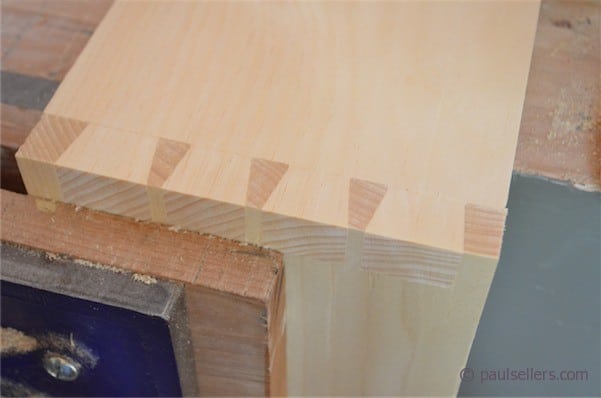Tails and Pins – Which is Best?
This highly provocative issue is a regular question for me and I usually avoid the controversy. I might be guessing here, but I would say that from my personal experience, most woodworkers who actually made their living from furniture making and woodworking in general cut their tails first. of course everyone is entitled to their opinion whether they are right or wrong. It’s a strange new world this world that changes with each typed symbol that others occupying the globe read, judge and pass opinions on as though just opinion alone somehow mattered. 
Resolving mistakes
I cut pins first only because I made a mistake. I don’t need to throw away a piece of wood that’s already fitted with dovetails to a previously made corner. The adjacent dovetailed effort may have failed because a piece of wood split wrongly or something and so I then cut the new tail piece from the existing pins. This is logical and resolves the issue. Like many things in life I have a choice of just two ways to do some things. I can walk forwards and see the future or I can walk backwards but not see where I am going. I cut tails first because cutting from the outside on push strokes using my native western-style saw means the outside fibres are supported as I push into the main body of wood. (That’s also the reason I don’t use Eastern-style saws too.) This means that I don’t get broken fibres on the visible outside corners of my dovetails (very logical, really) and so, when I press my dovetails together the corners are in tact and the dovetails look pristine. If I cut the tails from the pins I must then cut from the inside toward the outside face of the joint and the risk is that the crispness I seek can be lost. Aside from that, every craftsman I ever worked with, that guided me through my formative years to become a craftsman, cut their dovetails before they cut the pins. I never met a practicing craftsman from my youth who cut pins first. Knowing both ways means that repairs can be made when something goes wrong. Add into the equation that it is extremely difficult to cut half-lap dovetails accurately using the pins-first method, it makes sense to cut tails first as a matter of course. Understand that though we call through dovetails common dovetails, it is relatively more common to cut half-lap dovetails than through or common dovetails.


I think I understood that. If the pins are what I’d call the ‘Zinken’, then there are five in the picture above and we’re taught to make them first so we can mark out the wood for the ‘Tails’.
The point about the wood being supported hadn’t occured to me although I generally use a Japanese saw anyway. Frankly I wouldn’t care which way I cut them if I could make joins as tigh as the one in the picture. I’m getting there, slowly. I also have an exam soon…
I would love to hear your take on the history of leaving visible knife cut shoulder lines on the outside (visible) face of the tails.
I believe you use a pencil line to first rough the shoulder line and a knife after the tails are cut to define the shoulder line for the pins, leaving a pristine outer surface, which I prefer.
I have also ‘heard’ elsewhere that in some cases people add those lines to machine cut dovetails to create the appearance of ‘hand crafting’.
As a novice woodworker, leaving visible knife lines seems silly… but is there history here that I am not aware of? A perception I don’t share?
Thanks in advance,
Jeremy
I tend to mark with pencil and then use a shoulder line where the pencil shows I need to cut. I find this helps because I can use the line as a giide for my chisel by putting the point of the chisel into the groove. By penciling first I avoid having a groove on the visible part of the box, which is seen as highly unprofessional here, and I have a tendency to forget and line out everything. (we are taught to chisel dovetails out, not saw them I’ve no idea of this helps with a saw)
If you email me I have a gift for you.
I started doing tails first mainly because at times while dovetailing large boxes (10″ -12″ wide boards) some of my material after being milled has retained some cupping. I can mark out the tails cut them and then stick the board to receive the pins in my twin vise to straighten it out while marking the pins. If I do the pins first it is difficult to mark out the tails unless the material is perfectly flat because I have found it difficult to put the material in the vice while marking the tails from the pins. Once the joint is assembled the slight cupping is not an issue.
This is the only explanation I have found that makes sense and stands up to logical scrutiny. That is, the explanation of wanting to saw the pins from the outside in. Other than the fact that it is indeed much harder to cut half-blind dovetails pins first, any other explanation (or excuse) just didn’t make enough sense to me.
I learned to cut them pins first (from Frank Klausz) but always wondered why most people do it the other way around. Thank you Sir.